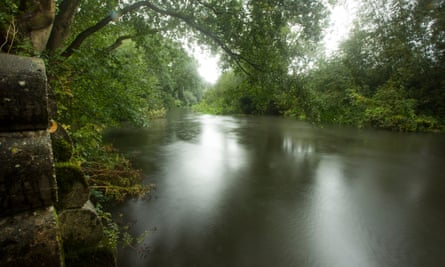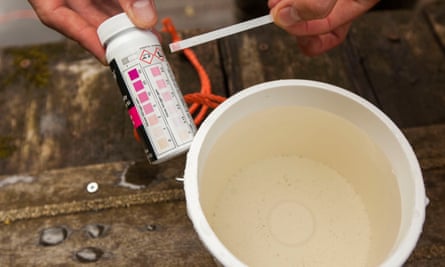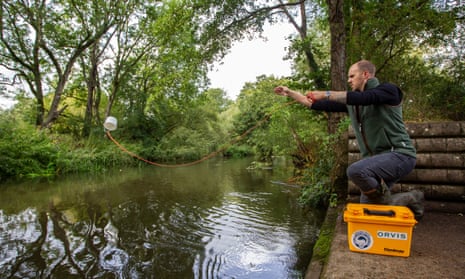If you go down to quiet stretches of river in the UK at the right time of year, you are likely to find people peacefully standing there with a fishing rod, gazing into the sparkling, steady flow, hoping to get a nibble.
Anglers, of which there are at least 2 million in England, go down to their treasured slices of waterway whenever they can to tend them, trimming vegetation, creating wetland spawning habitats, and even painstakingly cleaning the gravel. It sounds like a pretty peaceful pursuit, but when the Guardian went to visit some Angling Trust members at their clubs around Reading, there was palpable anger in the air.

This is because water companies have been spewing waste into many of these stretches, destroying the hard work, money, and hours of time anglers put in to keeping the rivers healthy. Now, they are fighting back with determined fishers all over the country testing their stretches of river for pollution using kits supplied by the Angling Trust. Often no one else will do it – reductions in testing by the Environment Agency mean many sites are not regularly tested, making it impossible to know the true state of sewage pollution in England.
150 volunteers have so far signed up to the sampling scheme in England, covering 50 rivers across 18 catchments, and more clubs are signing up every day. Their results so far are pretty grim – half of all samples exceeded the upper limit for phosphate, and 60% for nitrate. These are levels that can seriously damage rivers, as they promote algal growth and harm fish health. Elevated phosphate and nitrate levels are telltale signs of a potential sewage spill.
“It’s sad but necessary that anglers have to do this,” Martin Salter, the former Reading MP who is now head of policy at the Angling Trust, says as he looks ruefully at the River Loddon. This chalk stream has been found by anglers to have higher than average levels of phosphate and nitrates.

“This is proof of the fact that operator self-monitoring has been a colossal failure, as evidenced by Southern Water falsifying its own results,” said Salter. “We are determined to ensure that that kind of behaviour is not tolerated, and that we’ll use our results to call them out. We are going to use this scheme to find the truth, which we will then draw to the attention of both the government and the public.”
The Guardian joined Richard Maude from the Twyford and District Fishing Club as he tested the Loddon chalk stream, throwing in a little white plastic bucket to collect a sample to scrutinise. Their stretch of the river is a next to a wild-looking footpath; a secluded, tranquil oasis near a relatively urban area.
Maude has been fishing there for the last couple of years since he moved to the area, but has been angling since childhood. “Typical, like most working-class lads, I suppose; it was me my dad or my grandad that taught me how to fish and it just stuck with me,” he says.

And the people he fishes with near Reading have also mostly been taking part in the hobby since childhood, and are “in love” with the river. “Now, this river is fished by many people of a certain age – some have been fishing it for 50 years. Everyone’s just in love with the Loddon.
“It’s been fairly well documented for a while the pollution that has been pumped into the river, so we all want to do anything we can to help the situation, to assist, and if that means coming down here to collect a sample then we will do that,” adds Maude.
Anyone from the club would be well-primed to spot a pollution event – they spend more time staring at the river than perhaps any other users of our waterways.
“We’ve seen areas of the river that look different,” Maude says, “When it happens here, it looks to me like you’ve maybe poured red paint into the water; you can see that it’s kind of brown and horrible. It doesn’t look right. A lot of it is maybe instinctive for people that are used to looking at the river.”
Standing on the bank with Maude, the river looks gorgeous; you can just about see to the bottom. It has just rained, making the lush vegetation look even greener, and the riverbank is fringed with ripe blackberries, wild hops and plump sloes.
“At the moment, it looks exactly how a river should look,” he says, “But sometimes, bits of it look like old paintbrush water. That’s how you know something is maybe wrong. Now, hopefully, we can get the data to back this up.”
after newsletter promotion

Our next stop is the Swallowfield Angling Club. Members have rented their own field near their treasured waterway, complete with a wooden gate with a jaunty sign proudly emblazoned with the club’s name. They have access to both the Loddon and the Blackwater, and you can see how much effort members have put into helping fish numbers there. They’ve created a little wetland spawning area and keep the riverbank tended so it is rich with plants, but not overgrown.
Russ Hatchett, a painter-decorator, does the testing here. “I’ve been fishing all my life,” he says. “I’ve certainly noticed a slow decline of fish over the past few years in these parts. We’ve been reporting the fish which have been caught by anglers for the last seven years and there has certainly been a noticeable decline.”
The water here is fast-flowing, so you do not see the blue-green algal blooms that are a hallmark of sewage. But sometimes, Hatchett is shocked to see the usually clear waters marked with a telltale splotch of brown. For someone who spends hours and hours tending the river, this sticks in the craw.

“We notice a tea-coloured colour in the water, which isn’t right. We are very concerned, which is why we joined with the Angling Trust and take samples, and hopefully hold someone to task about this.”
There is real fury among anglers about the water companies, who can undo years of careful conservation work with just one spill.
“They shouldn’t be doing what they are doing,” he says, “It’s not right. I think everybody would say that if you ask them. Especially when we’re paying them as a member of the public for their services.”
Kristian Kent, from the Angling Trust, has a warning for the water companies. “We are not going away,” he says. “Citizen science is a reality of the world in the future, so they’re not going to be able to just sweep it under the carpet. If this was just one community group on the river, it’s easy to ignore. But now, when it’s 150, plus however many in the future, on most river catchments in England, it’s hard to ignore it.”
